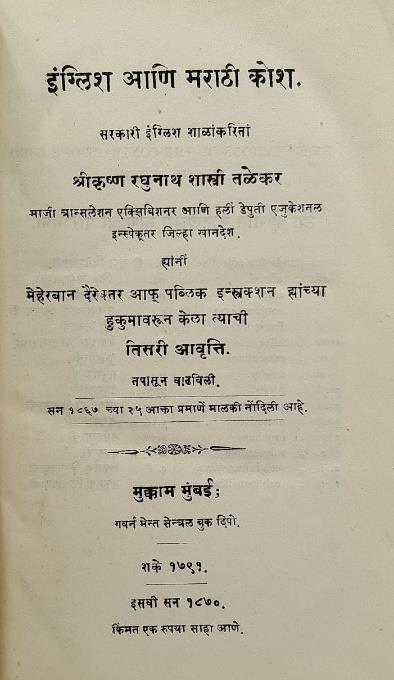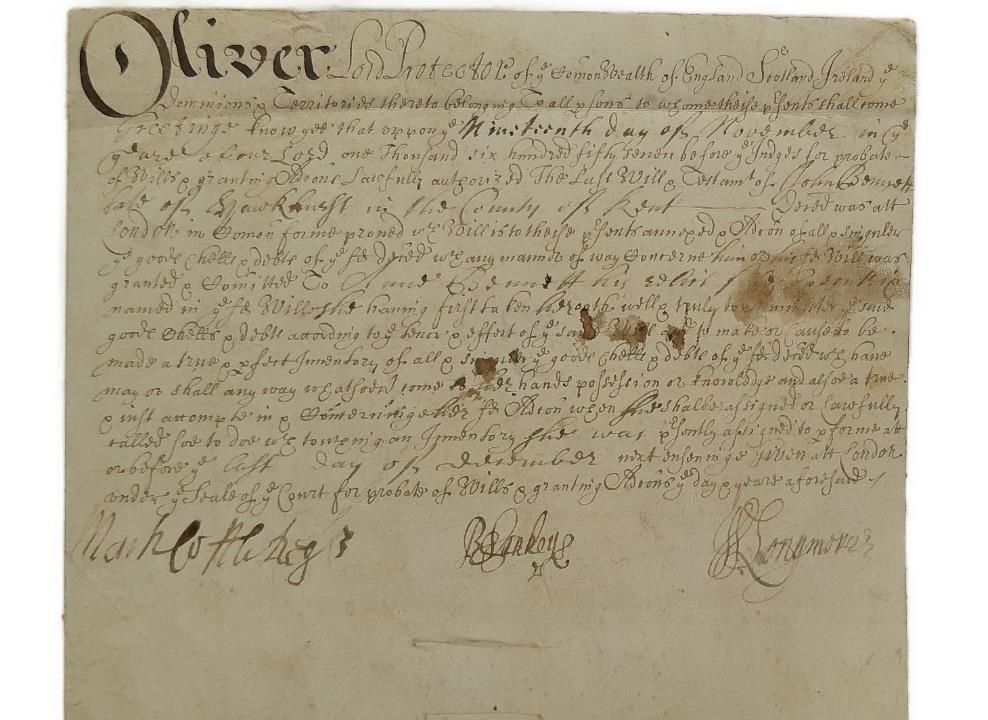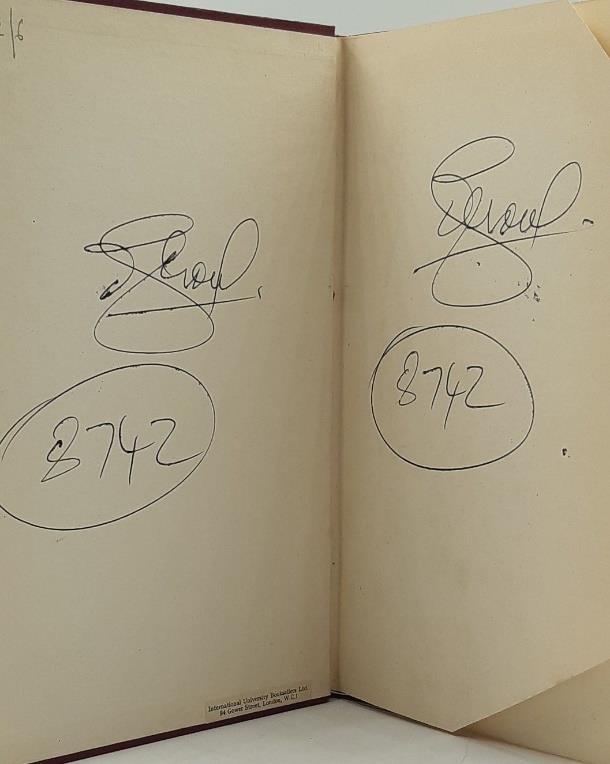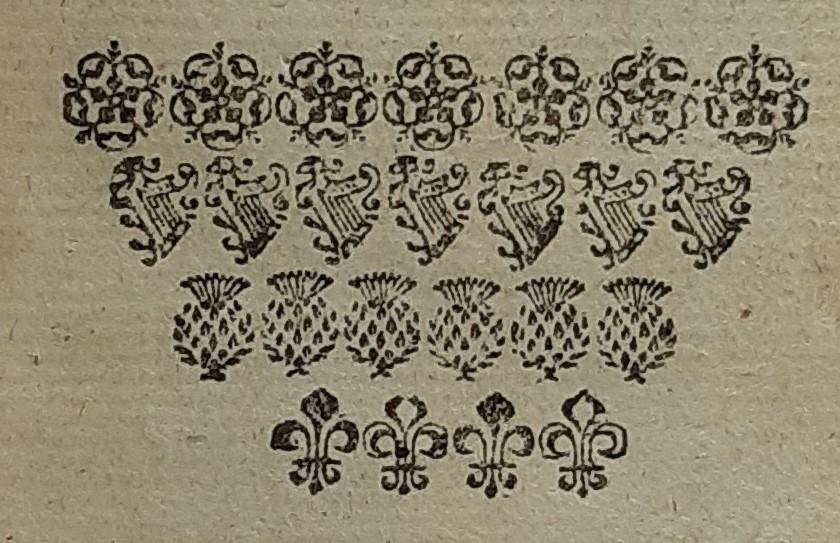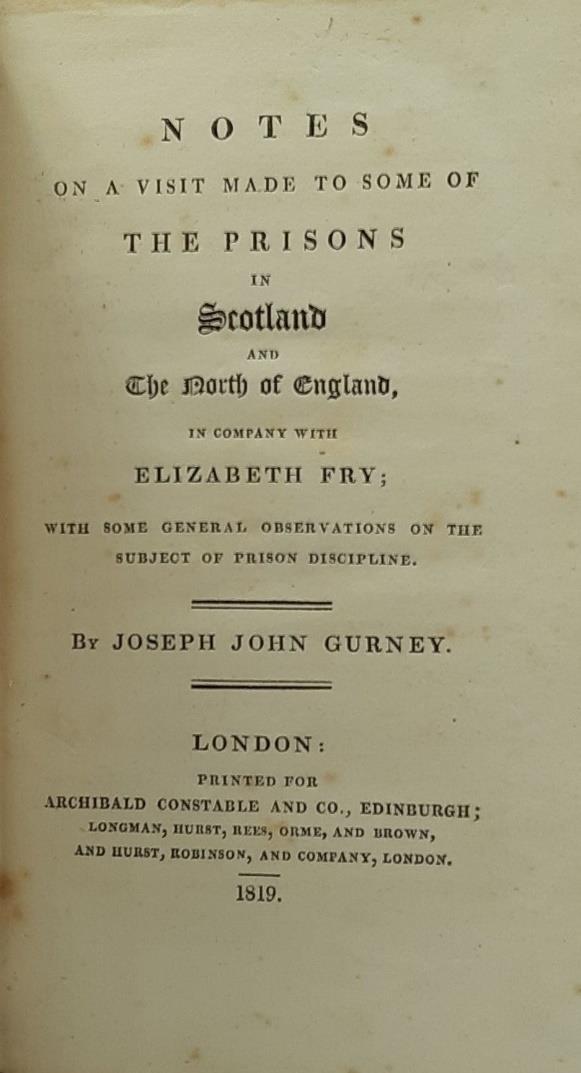

Too many people
1. MALTHUS, T.R. An Essay on the Principle of Population; or a view of its past and present effects on human happiness; with an inquiry into our prospects respecting the future removal of mitigation of the evils which it occasions. A new edition, very much enlarged. London: Printed for J.Johnson. 1803.

Second edition, known as the Great Quarto edition and, with its altered title and expanded and amended text, “regarded by Malthus as a substantially new work” (ODNB). Quarto, 265x205mm. pp. viii, [4], 610. Contemporary tree calf, expertly rebacked with original spine laid down, spine lavishly decorated in gilt, black morocco label lettered in gilt. Some rubbing to extremities, bottom corners strengthened. Front pastedown has book label of Christopher Clark Geest. Some slight foxing but overall a handsome copy of an important, influential and controversial book.
PMM (reference to the first edition) states that “the central idea of the essay - and the hub of Malthusian theory - was a simple one. The population of a community increases geometrically, while food supplies increase only arithmetically”. When the food supply becomes insufficient, the population is reduced by what Malthus calls “vice” (contraception, homosexuality, abortion) or “misery” (wars, famines, plagues). In the second edition Malthus sought to “lighten this ‘melancholy hue’” (ODNB) by arguing that were people to exercise some restraint and forbear the producing of children when unable to support them, then human happiness would be likely to increase. Those having to do the forbearing might, of course, feel otherwise and there is no doubt that Malthus’s views were not universally popular. But, given that similar “restraint” arguments are adopted in discussions on the link between population and climate change, perhaps Malthus is due a revival.

Anarcho-capitalism in the Oxfordshire countryside
2. [CHAMBERLIN, W.H.]. A plan for the employment of labourers, as adopted in Cropredy, and several other parishes

Banbury: Printed and Sold by J.G. Rusher. 1819
215x133mm. pp. 10, [2]. Original grey printed wrappers, split at head and foot of spine but otherwise in excellent condition. This rare little pamphlet, of which Worldcat locates only four copies, is a plea for the free market hiring of labour in Oxfordshire. Chamberlin was concerned that existing rules governed by the Poor Laws required farmers to pay to the Overseers of the Poor a charge linked to the value of their land. Any employment offered by the farmer was treated as a discharge of the farmer’s contribution to the Overseer with the result that two farmers could end up paying the same amount for relief of the poor but one had had work done on his farm while the other had not. And the poor labourer, whose rate of pay was fixed by the Overseers, would be in the same financial position despite having slogged away in the fields. Whilst the poor laws were a crucial safety net particularly in rural areas, there were concerns about the cost and bureaucracy of the system. Chamberlin sought to introduce a contractual, free market element allowing the farmer and labourer to agree a rate of pay which would encourage those who could, to escape from the dead hand of the poor law Overseer. Although Chamberlin notes in his introduction that his plan, adopted in November 1818, “has ever since been acted upon” it seems that it was only very briefly used and that by the 1821 this little experiment in wealth redistribution was, as is so often the case, defeated by the vested interests of the State.
[3972] £125
Fairy-Land: Tory Satire
3. ANONYMOUS [William Wagstaffe]. The testimonies of several citizens of Fickleborough, in the Kingdom of Fairy-Land, concerning the life and character of Robert Hush, commonly called, Bob. To which are prefixed, some memoirs of the life of Charity Hush, the grandfather, and of Oliver Hush, the Father of the said Bob.
London: Printed for John Morphew. 1713
First and only edition. 8vo in 4s. 180x115mm. pp. 23, [1]. In modern pink wrappers. Some slight foxing and staining to head of first gathering but overall a very good copy. Although published anonymously, this Tory response to Robert Hush’s (i.e. Robert Walpole’s) pamphlet The present state of fairy-land is recognised as the work of the doctor and satirist William Wagstaffe who moved in the same political and literary circles as Swift and John Arbuthnot (see below). This

1713 exchange of pamphlets was a skirmish in the propaganda battle between Whigs and Tories over British involvement in the War of the Spanish Succession. Walpole had criticised the Tory attempt to secure a peace settlement with France (which he called Slave-onia). This reply is a splendidly eighteenth century mix of obscure circumlocution and low insult.
ESTC: T99516
Economical with the truth
4. [ARBUTHNOT, John]. Proposals for printing a very curious discourse, in two volumes in quarto, intitled, Pseudologia politikē; or, a treatise of the art of political lying, with an abstract of the first volume of the said treatise.

London: printed for John Morphew. 1712
8vo. 182x118mm. pp. 22 [2pp. advertisements]. Sewn into modern grey wrappers. Final page has small stamp of Yale University Library Jun 18 19[81?]. In very good condition. John Arbuthnot (16671735) was highly regarded by contemporaries for his clever, supple mind and sharp pen. He was a member of the Scriblerus Club where he knew Pope and Swift (the latter is often said to have a hand in this work although he denied it) who admired Arbuthnot and felt that he should have taken greater credit for his talents as a writer, doctor and mathematician. More of his work would have survived had Arbuthnot not allowed his children to play with his manuscripts, scrawling over them and using them to light fires. Arbuthnot’s thoughts on the art of political lying (which were never - and never intended - to progress beyond this short, entertaining, Proposal) are developed out of the simple idea of “convincing the People of Salutary Falshoods, for some good ends” and the alarmingly cynical view that “the People…have no Right at all to Political Truth”. Of course, this is meant to be satire...but only just.
ESTC T75422
5. TROTTER, Thomas. Medicina Nautica: An Essay on the Diseases of Seamen comprehending the history of health in His Majesty’s fleet, under the Command of Richard Earl Howe, Admiral.

London: Printed for T.Cadell, jun and W. Davies 1797.

Volume II with subtitle: “with an appendix containing communications on the new doctrine of contagion and yellow fever, by American Physicians”. Longman and Rees, 1799.
Volume III with subtitle: “comprehending the history of health in the channel for the years 1799,1800, and 1801”. Longman and Rees, 1803. First edition. Three volumes. 8vo. 215x134mm. pp. Vol 1. viii, 487 [1bl]; Vol II. xii, 475 [1bl]; Vol III. vi, [2], 507 [1bl]. Engraved plate showing the Naval Medal presented to Dr Jenner in 1801 for his work on innoculation. Modern speckled half calf, marbled paper covered boards, spines with morocco labels lettered in gilt. Some foxing, repaired tears to N4 in volume one and G2 and L8 in volume two and bound without the four pages of advertisements in volume two but otherwise a very good set of an important work which revolutionised the health of sailors.
Thomas Trotter (1760-1832) studied medicine in Edinburgh but cut short his training to become the assistant to a surgeon on board a ship sailing to the West Indies. In 1781, his treatment of the wounded at the battle of Dogger Bank led to his being promoted to surgeon. In 1783 he joined a slave ship sailing from Liverpool. He was horrified by what he saw particularly when his advice to improve the diet of the slaves was ignored and an outbreak of scurvy ensued. He became an outspoken abolitionist, giving evidence to the House of Commons. He also worked on the link between poor diet and scurvy and was part of the team responsible for the provision of lemon juice to all British sailors. After returning to land to complete his medical degree, Trotter rejoined the navy and began “an unrelenting quest for reform in the medical department of the navy, much of which was discussed in his comprehensive three-volume work, Medicina nautica” (ODNB). Covering yellow fever, ague, catarrh, scurvy, smallpox, variola and vacciola, the ventilation of ships, diet, dysentery, malignant ulcers and typhus, it is comprehensive indeed.
ESTC: T101924
Ship shape
6. KNOWLES, John. An Inquiry into the means which have been taken to preserve the British Navy from the earliest period to the present time, particularly from that species of decay now denominated Dry-Rot.

London: Winchester and Varnham. 1821
First edition. Large quarto. 268x210mm. pp. [iii]-xv [1], viii, 164. Lacking half title. Blind stamp of the Royal United Services Institute Library at head of title page. Half calf, marbled paper covered boards, rebacked and corners repaired. Red morocco label to spine, lettered in gilt. Upper cover a little scuffed and edges rubbed. Front pastedown has presentation bookplate of RUSI with disposal stamp. Slightly foxed but overall a very good copy of an important book which resulted in the election of Knowles to be a Fellow of the Royal Society. Knowles’s work is a detailed study of the use and preservation of timber in ships. As he says in the preface, “the state and condition of the navy is a subject that cannot be too deeply studied, or too carefully attended to in this country; for whatever may be our political situation or connexion with the several Powers on the Continent of Europe, England should always recollect, that ships are her surest defence, for ‘her rampart is the sea’”. Knowles’s day job was a surveyor in the Navy Office and it must have paid well as he was also a discerning collector of art owning works by Titian, Rembrandt, van Dyck and Gainsborough as well as many paintings by his friend Henry Fuseli about whom Knowles wrote a three volume memoir.

All about boats
7. BLANCKLEY, Thomas Riley. A Naval Expositor shewing and explaining the words and terms of art belonging to the parts, qualities, and proportions of building, rigging, furnishing, & fitting a ship for sea. Also All Species that are received into the Magazine, and on what Services they are Used and Issued. Together with The Titles of all the Inferior Officers belonging to a Ship, with an Abridgment of their respective Duties.

London: Printed by E. Owen. 1750
First edition. 4to. 264x205mm. pp. [viii], 191 [1bl]. Engraved title page within an attractive rococo border and engraved illustrations on the left margin of each page and three engravings in the text. Contemporary calf, upper and lower covers with gilt dog-tooth border and gilt fleurons at the corners. Spine with five raised bands, compartments lavishly decorated in gilt although somewhat rubbed and faded. Tan morocco label lettered in gilt. Corners bumped and rubbed and a small scuffed patch on the lower cover. Marbled endpapers. Edges sprinkled red. Internally very good. Overall a very nice copy in a smart contemporary binding of the first illustrated maritime dictionary in English. The illustrations are in particularly good condition and give a charming pictorial addition to the definitions of almost every aspect of boats and sailing from anchors to wrain staves. Thomas Blanckley (17171753) was the Clerk of the Survey at Portsmouth Dockyard and Commissioner of the Victualling Office. In other words, a man who knew his ships.
ESTC: T131269

More about boats
8. MURRAY, Mungo. A Treatise on Ship-Building and Navigation. In three parts wherein the theory, practice, and application of the necessary instruments are perspicuously handled. With The Construction and Use of a new invented Shipwright’s Sector, for readily laying down and delineating Ships, whether of similar or dissimilar Forms. Also Tables of the Sun’s Declination, of Meridional Parts, of difference of Latitude and Departure, of Logarithms, and of artificial Sines, Tangents and Secants. By Mungo Murray. Shipwright, in his Majesty’s Yard, Deptford. To which is added by way of appendix, and English abridgment of another treatise on naval architecture, lately published at Paris by M. Duhamel, Mem. of the R. Acad. of Sciences, Fellow of the Royal Society of London, and Surveyor General of the French Marine. The whole illustrated with eighteen Copper Plates. London: Printed by D.Henry and R.Cave 1754

First edition. [4], iv, [4], 3-268, 73 [1]; [4], 70, [4]. Eighteen folding engraved plates including one with a volvelle. Contemporary calf, spine with red morocco label lettered in gilt. Upper cover slightly creased, corners bumped and a little worn. Head of spine rubbed and foot of spine chipped with loss of c1cm Front pastedown has armorial bookplate of Thomas Hall. Internally very good with only a little foxing and browning in places. An attractive copy in a very handsome eighteenth century binding. The elements of naval architecture: .. By M. Duhamel du Monceau has a separate titlepage, pagination and register. Loosely inserted is a leaf from a manuscript ship’s logbook (370x240mm) dated 11th-14th June describing part of a voyage of the Ship Prince Augustus (an East Indiaman) commanded by Francis Gostlin. but overall a very good copy of this exhaustive, detailed and groundbreaking work on ship-building. As Murray says in his preface, “though the art of Ship-building is of the utmost consequence to the trade and security of this nation...I cannot think of a subject which has been so little treated of in our language”. ESTC records ten copies of this first edition in the UK and eight in the US with a further two elsewhere.

Mungo Murray (1705-1770) joined the naval dockyard at Deptford in 1738 where he worked as a shipwright. Sixteen years of experience led to this book but he also, as he explains in the advertisement on the verso of the title page, had a sideline as a teacher of “the several Branches of Mathematicks treated of in this Book”, offering evening classes every day except Wednesday and Saturday. The hard working Murray also qualified as a teacher, serving on board ships as a tutor in navigation. He wrote a further book on this subject and a short note on an eclipse of the sun.
ESTC: T149899
[3989] £3,500
Grotian Proselytism. The Macclesfield copy of Edward Pococke’s Arabic translation of the De Veritate

9. GROTIUS, Hugo. De Veritate Religionis Christianæ Editio Nova cum Annotationibus, Cui accessit versio Arabica [Kitab Fi Sihhat Al-Shari’a Al-Mesihiyat. Translated by E. Pococke]. Oxford: Gulielm. Hall. 1660
8vo. 154x93mm. pp. [2], 180, [8], [4bl]; [372]. Contemporary mottled panelled calf, gilt double fillet border and gilt tooled panel with flower motif cornerpieces. Spine with four raised bands, compartments with gilt borders. First compartment with shelf label of Macclesfield library. All edges gilt. Front pastedown has Macclesfield Library bookplate. Some rubbing and slight scuffing but overall in very good condition throughout. Rare in commerce, this present copy was the last to have appeared at auction when it was sold at Sotheby’s in part eight of the sale of the Macclesfield library in 2006 where it brought £1,020
The text is Grotius’s De Veritate in Latin with the dedication to Robert Boyle by Edward Pococke whose Arabic translation follows Grotius’s work. The title then calls for the Annotations. These are not present here and, being a reprint from the Editio decima also of 1660, are not always present. The Latin text is a mixture of reprints and reissued sheets from earlier editions but the point of this book is not Grotius’s essay. Instead, as Madan notes in his bibliography of Oxford Books, “Of this book the Arabic version is the important part”. Madan explains that the Arabic translation “was carried out by Dr Edward Pococke, the Hon Robert Boyle paying the expense of printing. Boyle hoped thereby to promote missionary work among the Arabs”. Which is a roundabout way of saying the aim of the work was to persuade Jews and Muslims to convert to Christianity. Grotius believed that “the moral point of a religion was to elicit from men conduct appropriate to the needs of society, and Christianity fulfilled this purpose far better than its principal competitors” (Richard Tuck, Philosophy and Government, 15721651). Pococke, one of the greatest of all European Arabists, travelled widely in the Middle East, witnessing the divisions between the various religions in the region. He knew Grotius, discussed religion with him and, in the spirit of the great Dutch scholar, translated the de Veritate hopeful that Arabic readers might be persuaded of the social utility of Christianity.
Mickey Mouse degrees?
10. PRIESTLEY, Joseph. An Essay on a course of Liberal Education for Civil and Active Life With plans of lectures on: I. The Study of History and general Policy. II. The History of England. III. The Constitution and Laws of England. To which are added, remarks on a code of education, proposed by Dr. Brown, in a late treatise, intitled, Thoughts on civil liberty, &c.

[London]: Printed for C. Henderson 1765
First edition. 8vo. 203x120mm. pp. [4], iii, [1], 213, [11]. One engraved plate: “A Specimen of a Chart of Biography”. Nineteenth century half calf, marbled paper covered boards. Front pastedown has book plate of The Queens’ College, Cambridge and the stamp “Withdrawn from Queens’ College Library, Cambridge and disposed of”. Joint with upper board split but holding. Corners a little worn and some slight scuffing to spine and repair to head of spine. Internally very good and overall a nice copy of an early work in which Priestley argued that education should provide the useful, practical skills required for the young to become engaged members of society. So, classical languages, literature and history should disappear in favour of modern languages, mathematics, law and constitutional history. Thus a new class of aspiring bourgeois capitalists would be created and then entrenched, given that the poor were to be excluded from this education. Priestley’s set of syllabuses for history and law make fascinating reading and it is easy to see the appeal of his approach although it might be said to tend (avant la lettre) to the Gradgrindian. The work was a success: the year after its publication, the Warrington Academy to whom it was dedicated, replaced its classical curriculum with Priestley’s “Course of Liberal Education”.
[3982]
£450
Extensively annotated book of distinguished scholars of Westminster School
11. WELCH, Joseph. A List of Scholars of St Peter's College, Westminster as they were elected to Christ Church College, Oxford, and Trinity College, Cambridge. From The Foundation by Queen Elizabeth, MDLXI. To The Present Time. Including The Admissions Into The First Named College From MDCLXIII. To which is prefixed, A list of deans of Westminster; deans of Christ Church College, Oxford; masters of Trinity College, Cambridge: and masters of Westminster School.


London: Printed by J.Nichols 1788
First edition with extensive additional manuscript annotations. 260x200mm. pp. vii, [1], 172, [26 index]. Two engraved illustrated plates. Modern calf backed marbled boards, red morocco label lettered in gilt. Interleaved up to page 172 with blank leaves annotated in neat handwriting. There has also been added ll.173184 and pp185-239 which are blank leaves with extensive manuscript additional information about Westminster School scholars up to 1855. The index has also been interleaved with handwritten leaves and there are ten further manuscript pages at the end containing lists of college captains. Some slight foxing but overall very good. This is the only edition of this work but ESTC notes two issues although they are differentiated only by the extent of their additional manuscript annotations. This copy is significantly larger and more heavily annotated than either of these and for the enthusiastic “Old Westminster” (which numbers many distinguished names –Dryden, John Locke and George Herbert are here) this unique book will be the one that they want.
ESTC.
Inscribed by one great Irish scientist to another
12. LLOYD, The Rev. H. Lectures on the Wave-Theory of Light.

Dublin: Andrew Milliken. 1841

Presentation copy from author to the Earl of Rosse. First edition. 8vo.
222x140mm. pp. i-iv, 5-89 [1]; 83 [1]. Two folding engraved plates. Original green cloth, paper label to spine. Some staining to covers, spine faded, corners bumped. Internally very good. An important book creating an interesting link between two leading Irish scientists of the nineteenth century. The first part is a reprint of the six lectures given by Lloyd on unpolarized light in 1836 while the second part (on polarized light) appears for the first time. Rare in commerce.
Humphrey Lloyd (1800-1881) was the professor of Natural and Experimental Philosophy at Trinity College Dublin and was one of the leading proponents of the wave-theory of light - the idea that light is formed from vibrating waves rather than particles which was the Newtonian theory. This change was brought about in large part through a revolution in scientific methodology.
William Parsons, the 3rd Earl of Rosse (1800-1867) was president of the Royal Society, a builder of giant telescopes including the world’s largest at his home, Birr Castle in County Offaly. His most significant work was in astronomy. Lloyd and Rosse would have known each other as students at Trinity and must have remained in contact throughout their lives. Both were members of the British Science Association and Rosse became the Chancellor of TCD during Lloyd’s period as a senior Fellow. This book is a touching testament to an intellectual bond. [3987]

